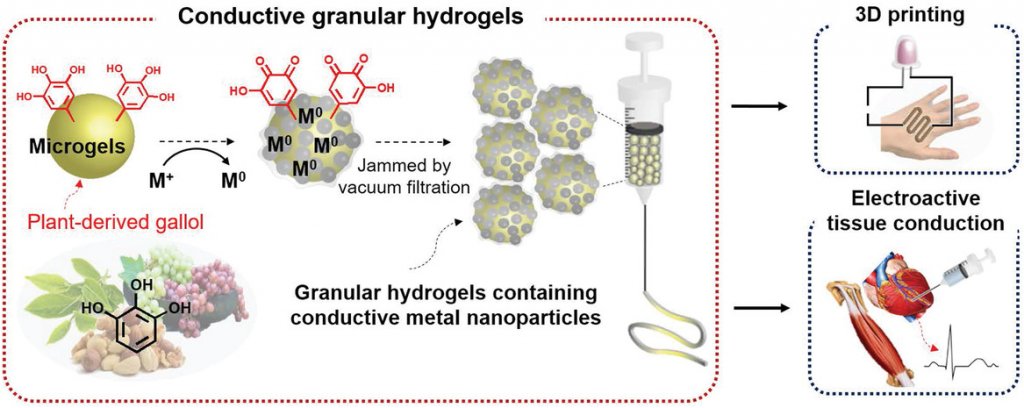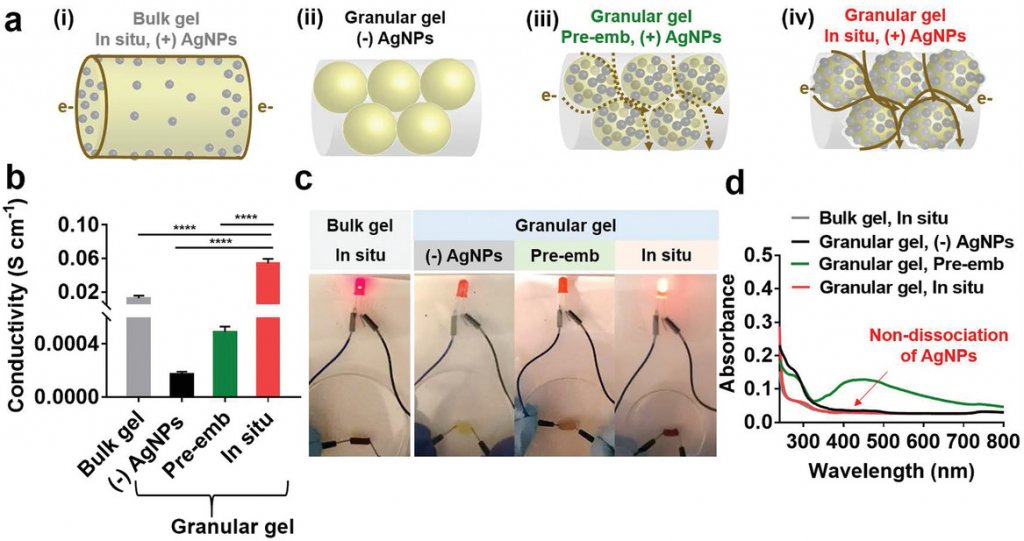To reach the goal of 3D printing human organs, bioprinting must continue to evolve. Researchers are not only aware of this, but as they are part of the process in seeking to make huge impacts in the medical realm, they continue to refine bioprinting in new studies like the one outlined in the recently published ‘Injectable and Conductive Granular Hydrogels for 3D Printing and Electroactive Tissue Support.’
 Authors Mikyung Shin, Kwang Hoon Song, Justin C. Burrell, D. Kacy Cullen, and Jason A. Burdick explain their approach to creating form injectable granular hydrogels through the following steps:
Authors Mikyung Shin, Kwang Hoon Song, Justin C. Burrell, D. Kacy Cullen, and Jason A. Burdick explain their approach to creating form injectable granular hydrogels through the following steps:
- Hydrogel microparticles are created with water-in-oil emulsions.
- Microgels are customized during an in situ reduction process.
- Microgels are ‘jammed’ into extrusion from a syringe.
Conductivity of the hydrogels was easily modified in the new concept created by the authors, based on the assembly of hyaluronic acid microparticles into solids containing metal-phenolic networks. Reduction is based on gallol moieties, common polyphenols with a natural base.
“The gallol moiety has benzene‐1,2,3‐triols, capable of being oxidized to form galloquinones and to donate two electrons per one molecule,” stated the researchers. “When coupled with this oxidation of gallol, metal ions (e.g., M+) are reduced to generate metal nanoparticles (e.g., M0). Furthermore, gallols may act as chelators to form coordinated networks with metal nanoparticles.
“Further, the intrinsic injectability of granular hydrogels allows fabrication of 3D printed electroactive patterns (e.g., wearable and flexible electronic devices) and electrophysiological support for biological tissues (e.g., myocardium, skeletal muscles).”
The in situ technique offers even greater potential than embedding, refining both conductivity and mechanical properties. The electrical conductivity of the hydrogels was explored further as the authors expected further enhancements due to a large surface area conducive to ‘continuous electric flow.’
Hydrogel structures and their variances impacted conductivity; for instance, within the microgels lacking AgNPs altogether, limited conductivity existed. With the addition of AgNPs, however, conductivity was improved. Size and morphology were noted to make a difference in conductivity too but thought to be dependent on ‘magnitude.’

3D printing of conductive hydrogels. a) Images of 3D printing process of the conductive granular hydrogels and morphology of the printed filament. The black arrow indicates a physical force (F) applied to the filament with needle translation during printing, showing self‐supporting of the filament. b) Printability of the granular hydrogels fabricated from microgels without AgNPs (“(−)AgNPs”) or with pre‐embedded (“pre‐Emb”) or in situ synthesized (“in situ”) AgNPs on the polymeric film and their free‐standing stability when removed with forceps. c) Schematic and images of transferring of the printed lattice of the conductive microgels onto porcine myocardium. d) Conductivity of extruded filaments as a function of volumetric mixing ratio v/v of the “(−)AgNPs” or “in situ, (+)AgNPs” microgels. One‐way ANOVA, Dunnett’s test for multiple comparisons to “100/0” filament, n.s. for not significant, **p < 0.01, ***p < 0.001. Scale bars: 100 µm for (a) and 3 mm for (b,c).

Bridging of conductive tissues with granular hydrogels. a) Schematic and representative image of ex vivo electrical tissue conduction test using isolated skeletal muscles and injection of granular hydrogels between the muscles. b) Electromyogram signals detected in the unstimulated muscle at a stimulation current of 100 mA. The arrows indicate action potential amplitude. c) Action potential amplitude detected in the unstimulated muscle during tissue bridging with the granular hydrogels, from (−)AgNPs, in situ, or pre‐emb microgels. n.d. for not detectable, *p < 0.05, **p < 0.01, two‐way ANOVA.
“Since the metal–phenolic coordination network involved in microgel interactions is dynamic and reversible, applications should consider the potential for dissociation of the microgels and whether further secondary crosslinking is needed for hydrogel stability. For instance, conductivity decreased from 0.05 to 0.01 S cm−1 when incubated for 5 days at body temperature due to a gradual loss of the physicochemical network between microgels,” concluded the researchers.
“The conductive granular hydrogels allowed 3D printable extrusion, fabricating free‐standable constructs on the polymeric film with conductivity as a function of the volumetric ratio of the microgels with/without metal nanoparticles. In addition, the conductive microgels restored electrical conduction by bridging two separated muscle tissues. Our findings present a new technique in the design of soft conductive materials that are also injectable, a promising approach for enhancing electrical conductivity for numerous biomedical applications.”
Bioprinting has led to the use of many different hydrogels—and a range of different research projects around the globe—from shape-shifting hydrogels to those that are created from chitosan or alginate. What do you think of this news? Let us know your thoughts; join the discussion of this and other 3D printing topics at 3DPrintBoard.com.
[Source / Images: ‘Injectable and Conductive Granular Hydrogels for 3D Printing and Electroactive Tissue Support’]Subscribe to Our Email Newsletter
Stay up-to-date on all the latest news from the 3D printing industry and receive information and offers from third party vendors.
You May Also Like
3D Printing Unpeeled: New Arkema Material for HP, Saddle and Macro MEMS
A new Arkema material for MJF is said to reduce costs per part by up to 25% and have an 85% reusability ratio. HP 3D HR PA 12 S has been...
3D Printing News Briefs, January 20, 2024: FDM, LPBF, Underwater 3D Printer, Racing, & More
We’re starting off with a process certification in today’s 3D Printing News Briefs, and then moving on to research about solute trapping, laser powder bed fusion, and then moving on...
3D Printing Webinar and Event Roundup: December 3, 2023
We’ve got plenty of events and webinars coming up for you this week! Quickparts is having a Manufacturing Roadshow, America Makes is holding a Member Town Hall, Stratafest makes two...
Formnext 2023 Day Three: Slam Dunk
I’m high—high on trade show. I’ve met numerous new faces and reconnected with old friends, creating an absolutely wonderful atmosphere. The excitement is palpable over several emerging developments. The high...

































